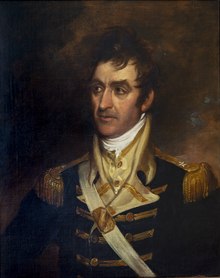
William Wadsworth (1765 in Durham, Connecticut – 15 February 1833 in Geneseo, New York) was an officer in the New York State militia, before and during the War of 1812. As a Brigadier General, he commanded the New York militia contingent in the American army at the Battle of Queenston Heights. He waived his right to command over Lieutenant Colonel Winfield Scott, of the United States Army. During the battle, he faced the enemy at all times so he would not be shot in the back and appear to be cowardly. Waving his sword and swearing at the troops back across the river, hoping to instill the fighting spirit in them, he made a genuine but vain attempt to get the militia to cross and reinforce their position.
At the end of the battle, Wadsworth was taken prisoner when the American force, cut off on the Canadian side of the Niagara River, surrendered to avoid a massacre by Indians under John Brant attached to the British force.